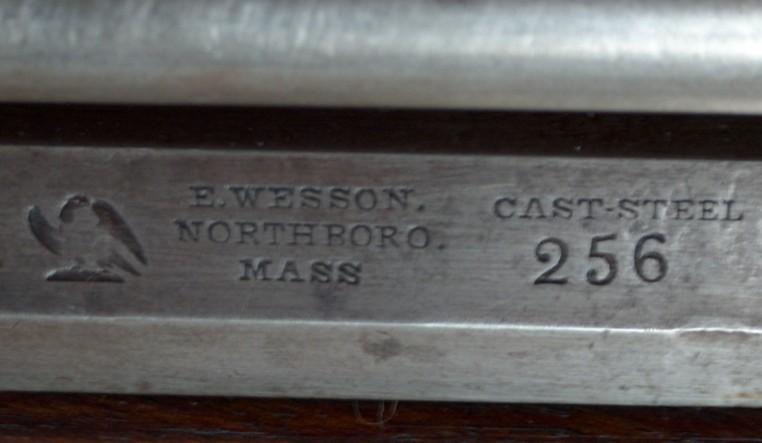The Wesson is most likely Edward Wesson. He is listed separately from Edwin Wesson.
Here's a quote from "American Gun Makers".
"WESSON, Edward— Grafton, Mass., 1834-40, then at Northboro until
1843 and later."
I don't find any information about Wesson & King, or even a King in the Mass. area.
The "back action" of the lock is typical of many guns made in the late 1830's thru 1860. Back action refers to the locks mainspring being behind the hammer rather than in front of it which is typical of locks from the mid 1600's thru 1870.
Edwin Wesson's information in "American Gun Makers" says this:
"WESSON, Edwin — Son of Rufus Wesson, a native of New Hampshire,
who migrated to Massachusetts and established a plow manu-
factory.
Edwin apprenticed himself to Silas Allen of Shrewsbury,
and later set up for himself at Northboro, where in association
with Leavitt he manufactured the Wesson and Leavitt revolver,
until his death in 1850. See Massuchusetts Arms Co. Edwin was
an older brother of Daniel B. Wesson."
I don't know if Edward was related to Frank Wesson or not but here is some information about Frank:
"WESSON, Frank— Brother of Daniel B. and Edwin Wesson. Arms
manufacturer of Worcester, Mass. Active about 1850-77. Maker
of Wesson pistols, military carbines and sporting and target rifles,
under the patent of Frank Wesson and N. S. Harrington of Oct.
25, 1859. No. 25,926, and the numerous Frank Wesson patents
of Nov. 11, 1862; Dec. 15, 1868; July 20, 1869; June 13, 1871 and
July 10, 1877."
Daniel is the man who was instrumental in the creation of Smith & Wesson. Here is some information about him from the same source.
"WESSON, D. B.— Daniel Baird Wesson, one of the founders of Smith
& Wesson, was born at Worcester, Mass., in May, 1825, of an
old New Hampshire family of English descent. After a brief
attempt to interest himself in the shoe business with his brothers
Rufus and Martin, Daniel joined his brother Edwin at Northboro
in 1843, and completed his apprenticeship in 1846. He continued
with Edwin until about 1850, when his brother died. After work-
ing for a time for his brother Frank, who had a gunsmith shop
at Grafton, and with Leonard at Charlestown, Mass., as super-
intendent of the Leonard pepperbox pistol plant, Wesson went
to work for Allen, Brown and Luther at Worcester, Mass., in
1852. There he became associated with Horace Smith and the
Volcanic Repeating Arms Co., and later formed the Smith &
Wesson arms manufacturing firm. See Smith & Wesson. Daniel
B. Wesson died at Springfield, Mass., August 4, 1906. "





























